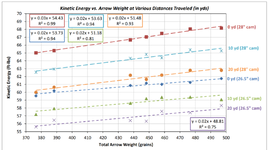jstanton007
Lil-Rokslider
- Joined
- Aug 2, 2024
- Messages
- 108
I was looking a different arrow results from a few configurations I fletched up for a buddy's bow as an experiment. I was a little surprised by the results as I would have thought the difference in KE would have been greater given a 54gr weight difference in the two arrow setups and only a 13fps difference in speed.
Bow Setup: Mathews Phase 4, 28.5" draw length, and 65lb draw weight.
Arrow #1: Easton Axis 5mm, 75gr steel half-out, AAE Max 3 Fletch, valley of nock to end of half-out 28.25". Total arrow weight 476gr, including 100gr field point, is the actual weight measured. Clocked the arrow at 258fps and using various KE calculators I get about 70.37lbs of kinetic energy.
Arrow #2: Victory RIP V3 5mm, 60gr steel half-out, AAE Hybrid 3 Fletch, valley of nock to end of half-out 28.25". Total arrow weight 422gr, including 100gr field point, is the actual weight measured. Clocked the arrow at 271fps and using various KE calculators I get about 68.83lbs of kinetic energy.
For me I would go with the Victory RIPs for more speed and only slightly lower KE. I don't really focus on FOC too much and both are about the same FOC sitting around 14.6-14.8%. I actually balanced the arrow and measured it to attain these FOC numbers. I would rather have the flatter shooting faster arrow if I am only giving up 1.54lbs of KE. In hunting situations and judging distances on the fly the faster arrow is more forgiving. Using a drop calculator I found online there is over an 11" difference in drop at 70 yards between these two setups. My buddy is hung up on the most kinetic energy possible, due to shoulder reasons he cannot shoot more than 65lbs, but I think it's not enough difference to really matter on KE. A few more details are this setup is an all around arrow setup for whitetail, mule deer, and elk for which he will be shooting fixed blade Day Six Evo broadheads.
What says the Rokslide braintrust?
Bow Setup: Mathews Phase 4, 28.5" draw length, and 65lb draw weight.
Arrow #1: Easton Axis 5mm, 75gr steel half-out, AAE Max 3 Fletch, valley of nock to end of half-out 28.25". Total arrow weight 476gr, including 100gr field point, is the actual weight measured. Clocked the arrow at 258fps and using various KE calculators I get about 70.37lbs of kinetic energy.
Arrow #2: Victory RIP V3 5mm, 60gr steel half-out, AAE Hybrid 3 Fletch, valley of nock to end of half-out 28.25". Total arrow weight 422gr, including 100gr field point, is the actual weight measured. Clocked the arrow at 271fps and using various KE calculators I get about 68.83lbs of kinetic energy.
For me I would go with the Victory RIPs for more speed and only slightly lower KE. I don't really focus on FOC too much and both are about the same FOC sitting around 14.6-14.8%. I actually balanced the arrow and measured it to attain these FOC numbers. I would rather have the flatter shooting faster arrow if I am only giving up 1.54lbs of KE. In hunting situations and judging distances on the fly the faster arrow is more forgiving. Using a drop calculator I found online there is over an 11" difference in drop at 70 yards between these two setups. My buddy is hung up on the most kinetic energy possible, due to shoulder reasons he cannot shoot more than 65lbs, but I think it's not enough difference to really matter on KE. A few more details are this setup is an all around arrow setup for whitetail, mule deer, and elk for which he will be shooting fixed blade Day Six Evo broadheads.
What says the Rokslide braintrust?


